It’s been said that a Cybertruck slide-in camper was impossible. Too many angles. Not enough space. Then Robby Rowe of Phoenix Campers took the challenge. Think the Cybertruck can’t be tamed for a slide-in? Think again!
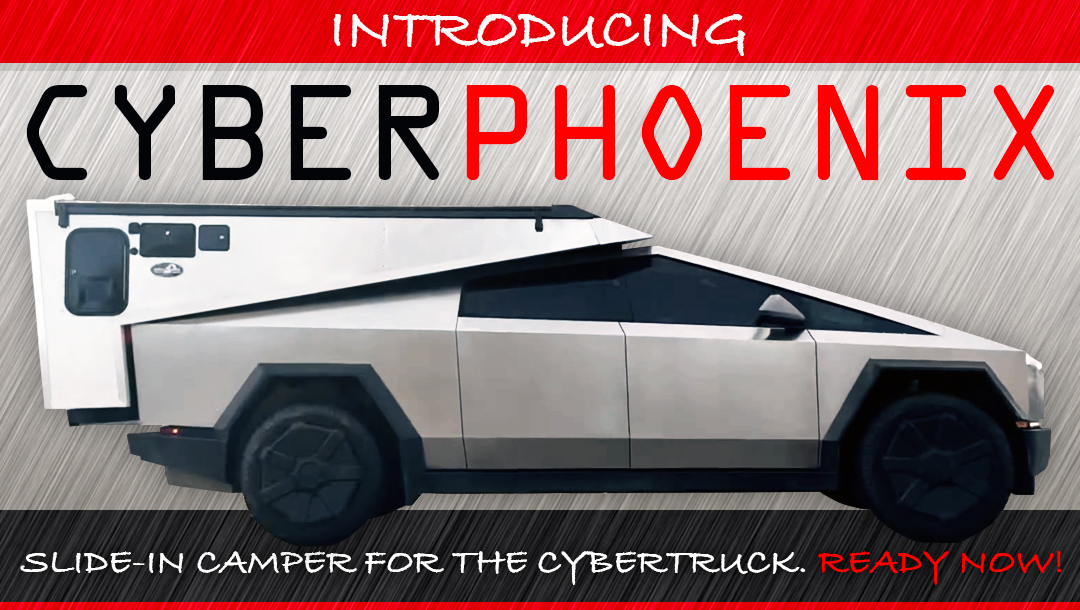
When Tesla unveiled the Cybertruck, it was clear that this was not just another pickup. With its angular, futuristic design, it promised to shake up the world of electric trucks. But for those who love overlanding and off-grid travel, one big question remained: Could you design a slide-in camper for it?
That’s where Robby Rowe and Phoenix Campers stepped in. Known for custom-built truck campers that no other company would dare attempt, Robby saw the Cybertruck’s unique shape not as a roadblock, but as a design challenge.
The result is the CyberPhoenix, a true slide-in truck camper made specifically to fit the Cybertruck’s unconventional bed while preserving the efficiency and functionality Phoenix truck campers are known for.
In this interview, Robby Rowe walks us through the process of creating a camper for a vehicle that defies traditional truck design. From matching the Cybertruck’s windshield slope for better aerodynamics to figuring out how to secure the camper without extra hardware, every aspect of the project required problem-solving and creativity. Along the way, Robby and his team experimented with materials, rethought storage layouts, and even had to get a little old-school—starting some of their design work with nothing more than cardboard templates.
This conversation offers a look behind the scenes at the CyberPhoenix’s development, including the challenges, unexpected discoveries, and practical solutions that made it all work. If you’ve ever wondered what goes into designing a camper for an unconventional vehicle, this is a deep dive.
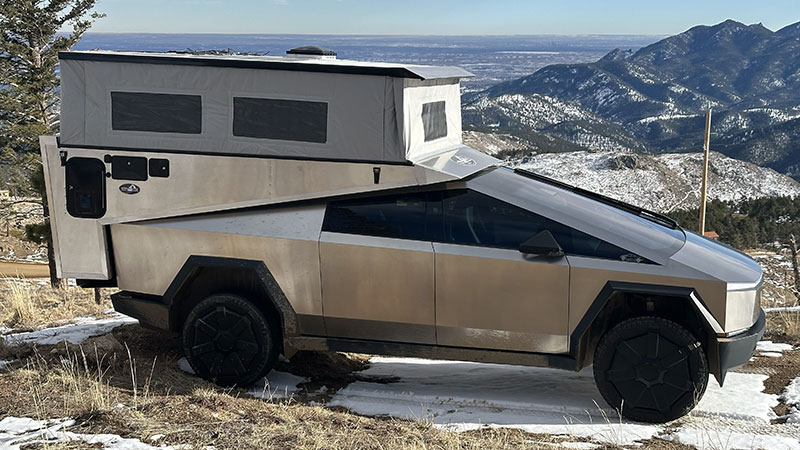
Above: The CyberPhoenix in Estes Park, Colorado. Outside photos courtesy of Eddie Haemmerle of CyberTruck One
How did this project come about at Phoenix Campers?
When Ford announced its electric trucks, we started thinking about designing a camper specifically for EVs. My son, Shane, and I asked ourselves, “Wouldn’t it be amazing to build a lightweight, aerodynamic camper that could travel long distances without severely impacting range—one that could even charge the truck while camping?” The idea was born years ago, but we weren’t in a position to buy a Cybertruck ourselves and experiment. So, we waited for the right customer to come along.
Fast forward to today, and we’ve already built campers for hybrids and the Ford Lightning. Then Eddie Haemmerle of CyberTruck One reached out to us, eager for a Cybertruck compatible camper. He had ideas of what he wanted. From there, I designed a model tailored to his needs. We’ve been refining it for months.
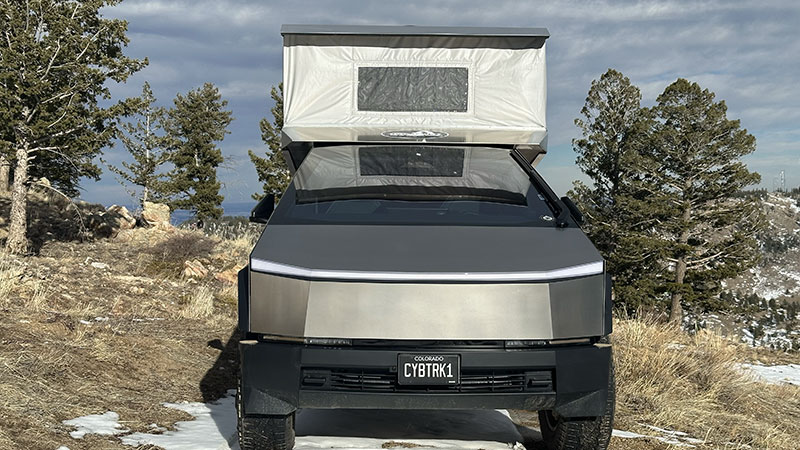
Some say the Cybertruck’s unique design makes it nearly impossible to fit a slide-in camper. How did you overcome that challenge?
The Cybertruck definitely presents a unique set of challenges. The truck bed is angular, tall, and has no wheel wells—meaning traditional camper designs wouldn’t work. I’ve always believed a camper should include all essential amenities while feeling as homey as possible. That was our guiding principle.
Our solution was to elevate the seating over the tall bed sides, ensuring comfortable knee space. This also allowed us to create a spacious dinette without users feeling like they were sliding down a slope.
Another big challenge was the aerodynamics—particularly matching the Cybertruck’s windshield slope to maintain efficiency. We designed the camper’s cab-over section to complement that angle and avoid unnecessary drag.
The CyberPhoenix is exceptionally low-profile. If the truck is set to its medium or low suspension setting, the camper fits in a standard 7-foot garage. Plus, thanks to the Cybertruck’s naturally sloped bed, we integrated underbed storage in the bedroom and underfloor storage in the seating and dinette area.
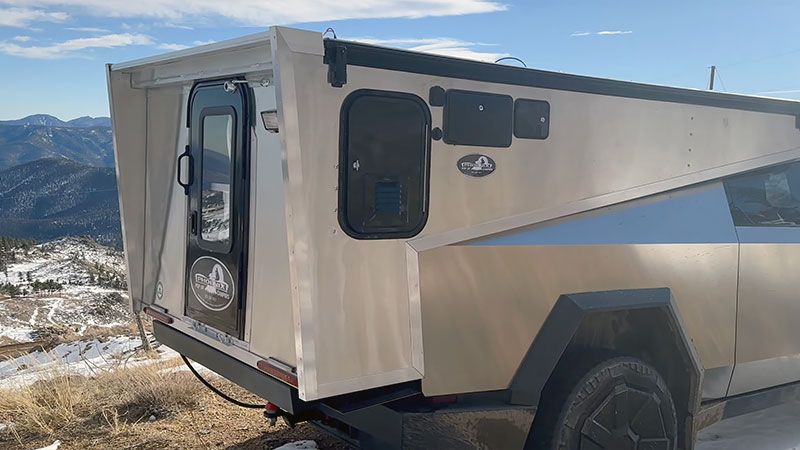
Did you have a Cybertruck on hand to ensure the perfect fit?
Eddie, our customer, brought in his Cybertruck for two critical measuring sessions—one at the beginning and another mid-build. In total, I spent about eight hours with the vehicle to refine our approach. The final design echoes some of the 1950s and 1960s tail fin stylings, but with a modern Cybertruck twist.
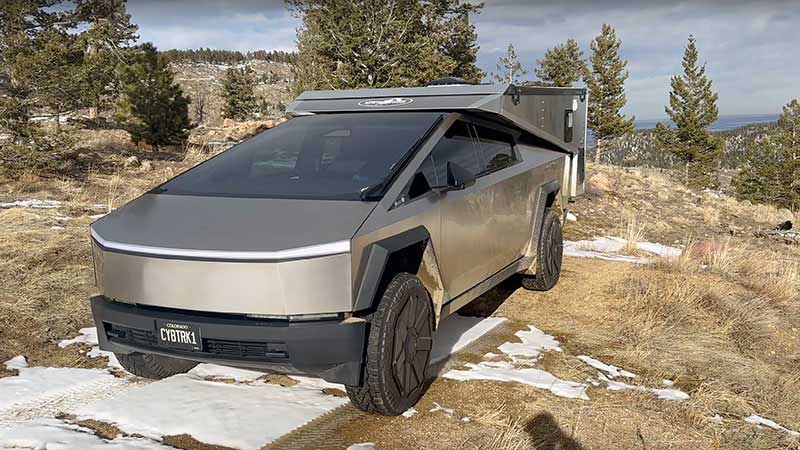
How did you match the Cybertruck’s windshield angle?
It was tricky. The tip of the camper is so pointed that our neighboring metal fabrication shop had trouble bending the material back tightly enough. We had to experiment with alloys to get the right bend. Believe it or not, I initially mapped out the shape using glorified cardboard—sometimes, high-tech designs start with the simplest methods.
Tell us about the compartments and features on the exterior.
On the passenger’s side, the camper has a water fill and hook-up, a shore power inlet, an auxiliary solar socket for portable panels (in addition to the 800-watts of solar on the roof), and a full-size 20-pound propane tank with a gauge.
The rear of the camper features fold-up steps for easy access and an LED porch light. The driver’s side has a 10 inch by 12 inch marine hatch that provides easy access to a good-sized storage compartment and a six-gallon water heater.

Is the CyberPhoenix’s exterior made of stainless steel, like the Cybertruck?
No. We used high-quality RV aluminum siding for weight efficiency. We polished it to a sleek finish once the camper was completed.
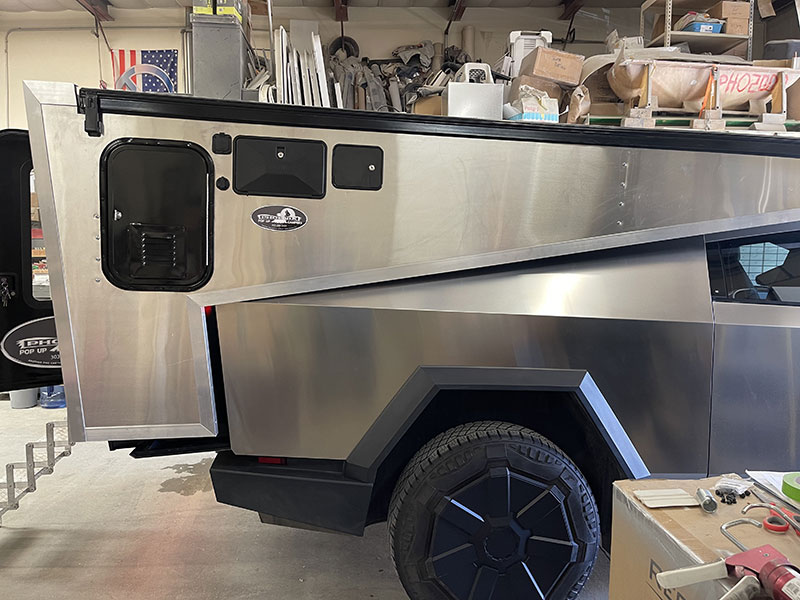
Above: Note the fitment to the Cybertruck angles. Interior photos courtesy of Phoenix Campers.
Are those rivets in the side metal?
Those are chrome machine screws that thread into steel brackets inside the camper. The machine screws are for the camper jacks to attach to when you need to load and unload the camper. It takes less than five minutes to install the jacks. Once the jacks are installed, you can raise the camper up and drive under it.
What did you use for tie-downs and turnbuckles?
The way it’s tied down is cool. There are built-in tie rails on both sides of the Cybertruck and special connectors that go into the L-track. We use ratchet straps attached to these connectors. It’s quick and easy and no extra hardware is required on the vehicle at all.
To get to the ratchet straps, there are two trap doors under the dinette seats. You move the dinette cushion, open the trap door and you can tighten them.
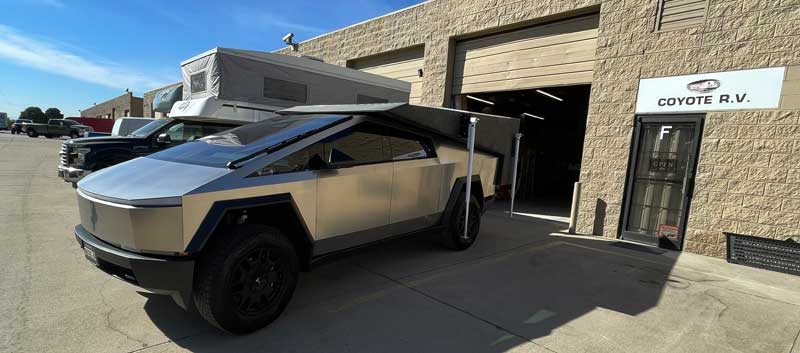
It should take 15 minutes to load the camper. It’s not a tight clearance squeezing through the tailgate. There are special slots in the camper for tailgate cables. If you are close at all, the slots will line up as you get to the tailgate portion.
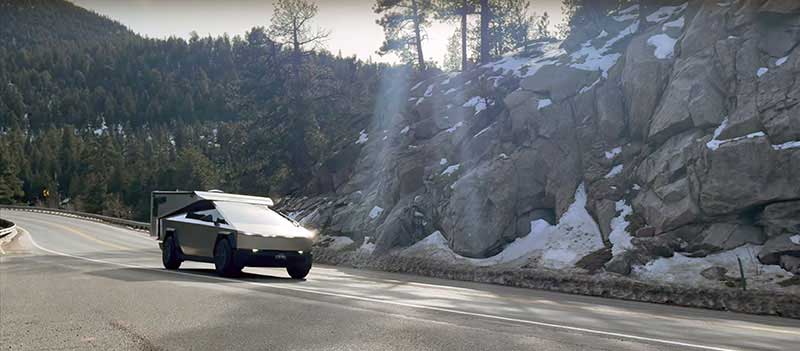
How do the Cybertruck and the CyberPhoenix connect for brake lights?
It’s just like any other pickup truck. The CyberTruck has a 7-pin trailer hitch plug. We installed the male plug on the camper. When you load the camper, you line up with the Cybertruck’s hitch plug, plug it in, and you’re good to go.
Is the roof also aluminum?
Yes, but it’s the standard white aluminum roof we use here at Phoenix Campers. I wanted the roof white to keep the camper cool inside. It’s mostly solar panels up there, so you don’t see the roof color too much.
What type and wattage are the solar panels?
Robby: The solar panels are semi-flex monocrystalline panels. They are seven pounds a piece and have minimal wind resistance. There are 800-watts in total on the roof.
It was our idea to have enough solar to be able to slow charge the truck when camping and have enough power to run the equipment in the camper.

Is there room for more solar on the roof?
I think we could get 200 more watts up there. I have crazy ideas to make room for more panels if a customer is interested.
What roof lift mechanism did you use for the CyberPhoenix?
It’s a push-button electric lift with actuators. It’s got three actuators located inside the camper. We did the extra tall pop-up for extra headspace. With the top-up, it’s 6’3” inside and you can sit up in the bedroom area.
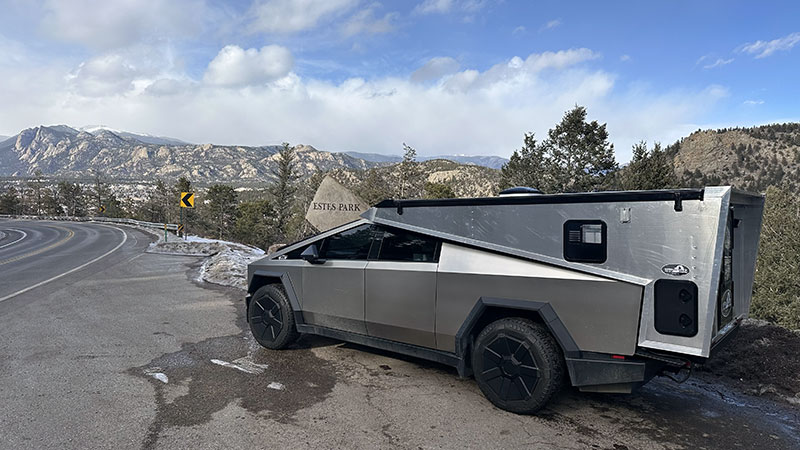
What’s the total height of the truck and camper when the roof is down?
When set to the medium height setting, the total height is 83 inches (6’11”)—lower than most of our other campers. This gives it aerodynamic advantages over traditional truck campers.
Was the Cybertruck’s factory composite bed suitable to place the camper directly on, or did you need a rubber mat?
I put the camper directly on the truck bed. The aluminum base of the camper isn’t steel and shouldn’t scratch the truck bed.
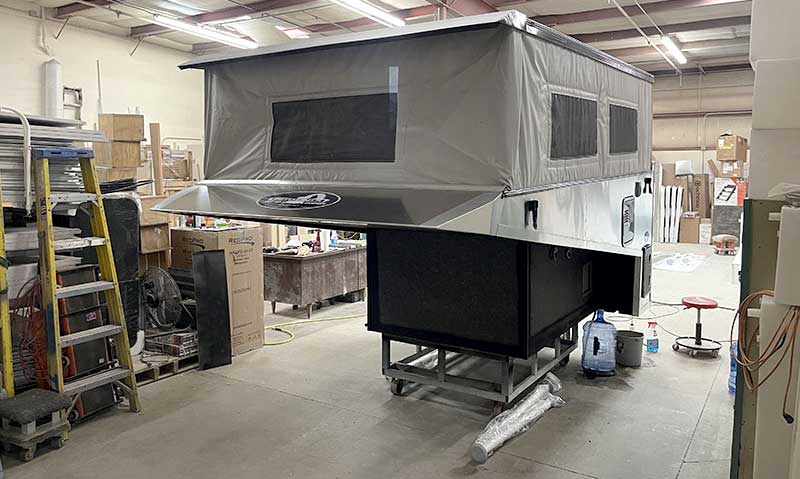
What materials did you use to frame and build the CyberPhoenix?
The main core is made from Space Age Synthetics composite panels. It cuts and can be worked like a wood panel. It’s strong, lightweight, and waterproof. The inside is Adzel composite board. That’s the paneling you see on the interior.
The outside is sheet metal aluminum. The only other structural component is the exoskeleton. There’s a 2×2 outer aluminum casing that is on all the edges of the camper. The casing gives the unit extra strength and trims out the camper.
What are the tank sizes of the 2025 CyberPhoenix?
There are 20 gallons of fresh, no grey tank, and a porta-potty. The shower and kitchen water exit outside. With a hose attachment, you can catch the grey water in a portable waste tank or expandable container.
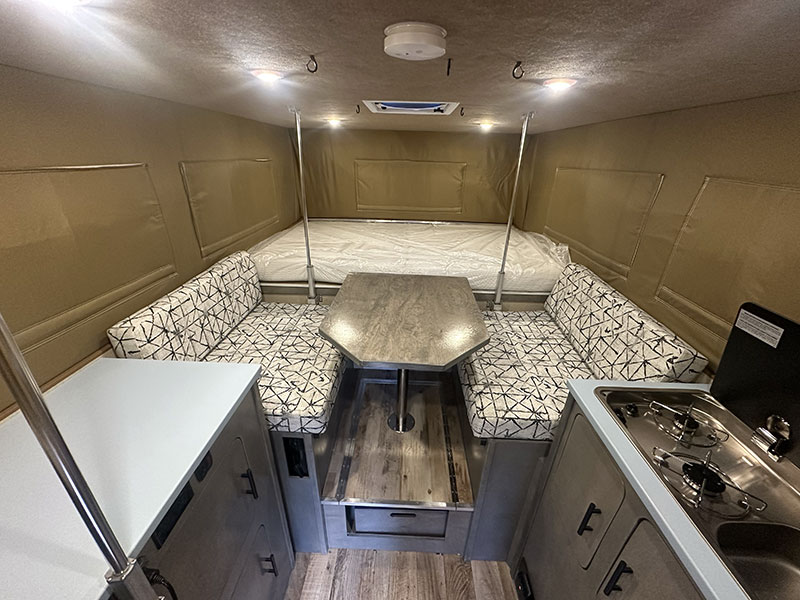
Were you able to make this a full-blooded Phoenix Camper with standard systems and components?
Yes. There’s a Dometic six-gallon water heater. We are using a ProCom heater. It was the only propane heater that fit. Eddie has been testing the effectiveness. He has also been using an electric heater powered by his truck.
The shower is Sobo Bullfinch shower fixture. We’ve been using that for a while now for our exterior showers. It’s located in the dinette. It shuts off when you disconnect the hose. It’s good for a quick interior shower.
“The CyberPhoenix is set up to be fully self-sufficient without the vehicle.”
Does the CyberPhoenix have its own battery, or is it using the Cybertruck’s battery?
Every electric truck owner that has come to me has asked the same exact question.
My thought is, “Do you want to pull from the truck’s driving battery source when you camp?” There’s lots of power there, but isn’t it better if you don’t have to pull power from the vehicle? And it is even better if you can feed power back into the truck when you camp.
The CyberPhoenix is set up to be fully self-sufficient without the vehicle. It is possible to use the CyberTruck’s battery, but my personal opinion is to let the truck power itself and not pull from it, and maybe even charge it.
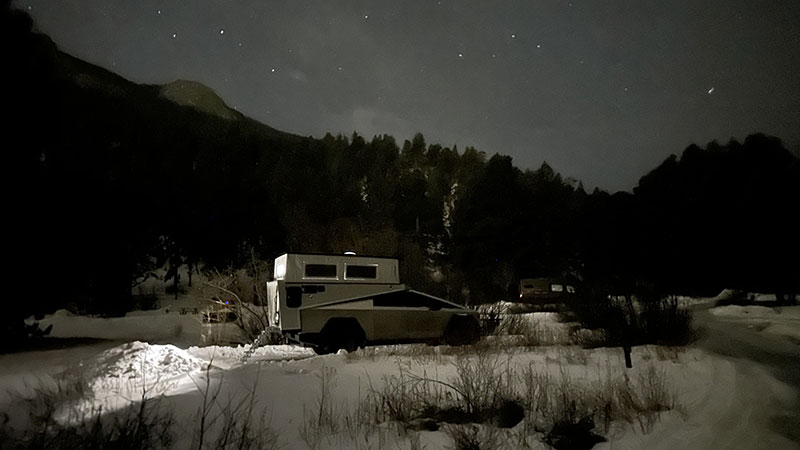
Tell us about the standard battery and electrical system in the CyberPhoenix.
There’s a 400 Ah lithium battery, 800-watts of solar, a 2000-watt inverter, and an auto transfer switch. It’s the same quality and style of electrical system as our regular campers, but it’s beefed up to support the Cybertruck if you want to.
Why not make the CyberPhoenix entirely electric?
It’s an option, but we decided to save electricity for driving and use propane for heating and hot water. A 20-pound propane tank takes up minimal space and provides a reliable heat source, especially in winter.
Being based in Colorado, we know that cold weather significantly reduces lithium battery performance. If a camper relied solely on the truck’s battery, you could run into a dangerous situation—stranded in freezing conditions with no heat. Propane ensures you stay warm without compromising the truck’s range.
Could you build an all-electric version of the CyberPhoenix?
Absolutely. If that’s what a customer wants, it would be easy to build an all-electric CyberPhoenix.
Is there an option for an air conditioner?
Yes. We can either do a 12-volt or 110 roof top air conditioner. We’ve installed the Dometic 12-volt air conditioners and they are efficient.
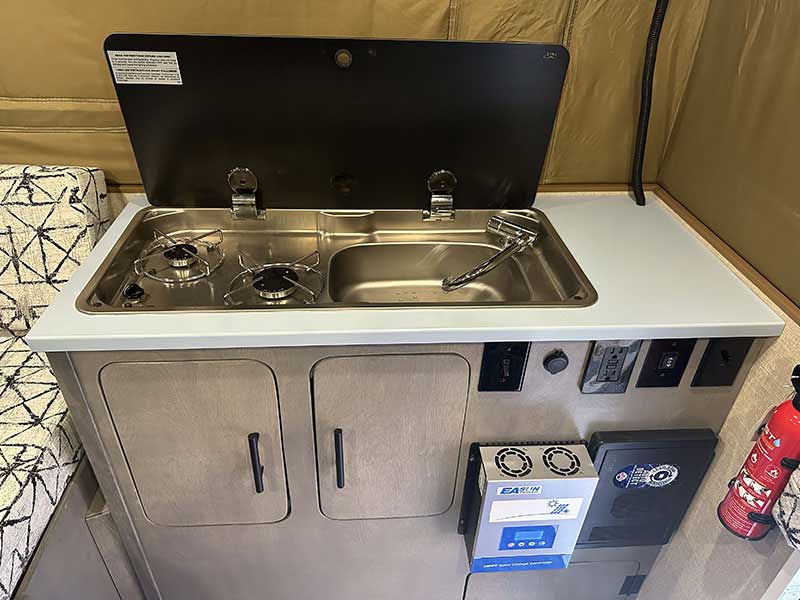
Where is the storage in the CyberPhoenix? Is there underbed storage?
Yes, there’s underbed storage. The cool thing is that it slopes down toward you; 6-feet wide, and 8 inches to 0 inches at the nose tip. It’s a ton of storage space.
Under both dinette seats, there’s storage. There’s a storage box under the foot rest that you can carry in the house. The box is 10-inches tall by 14-inches wide by 3-feet long. It’s a big box.
There’s storage next to the water heater on the driver’s side. There’s a lot of kitchen cabinet storage below the stove and sink. There’s a storage area on the bottom of the kitchen on the right, but that’s for the porta-potty.
What size porta-potty can fit in that space?
It’s a Thetford 135. You could use your shower curtain for privacy for the porta-potty, if you install ceiling hooks. The rear portion of the camper could have some privacy.
Is there anything else located under the dinette seats?
On the driver’s side of the dinette is an actuator to lift the roof, the water pump, the 20 gallon water tank, and the strainer for the pump. On the passenger’s side, you’ll see the battery, the inverter, and the wiring. There’s also storage.
Tell us about how the inside shower works in the CyberPhoenix.
You’ve got a storage box that sits on the shower pan under the foot rest. To take a shower, take the table off, flip up the foot rest, and take out the shower box. The shower pan is ready. Put the shower curtain hooks on the ceiling, plug-in the Sobo Bullfinch shower connection and you’re done.
The drain is in the front passenger’s corner of the pan. There’s a 3/4-inch hole in front right corner and it’s sloped to that corner. After showering, wait a minute or two and dry it out with a paper towel.
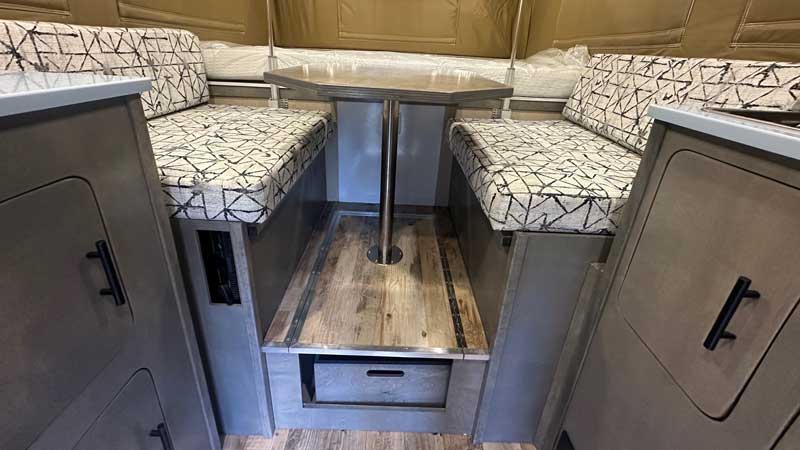
The dinette cushion fabric is very clever in how it playfully mirrors the Cybertruck design concept. Can CyberPhoenix customers choose their fabrics and interior finishes like on other Phoenix Campers?
Yes. You can choose your stain color. This one was grey. You can choose your upholstery fabric for the dinette and curtain, and your countertop color. It’s fully customizable.
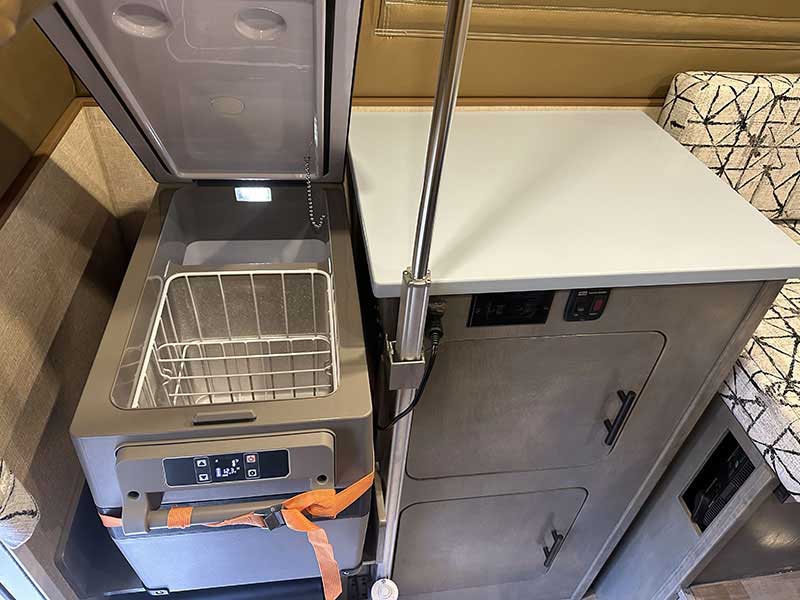
What refrigerator comes standard in the CyberPhoenix?
A 48-quart 12-volt compressor fridge/freezer comes standard. If someone already has a cooler-style refrigerator that fits the available space, we can credit that feature.
What options are available for the 2025 CyberPhoenix?
With the limited space available, we tried to limit the options. The CyberPhoenix comes loaded. You can add an awning, rooftop air conditioner, an additional 400 Ah battery, and an additional 200-watt solar panel. It probably makes more sense to use a large portable solar panel and plug it into the solar input.

What’s the estimated weight of the CyberPhoenix?
We haven’t officially weighed it yet, but we estimate it at around 1,350 pounds dry. The Cybertruck, with its 2,500-pound payload capacity, handles it effortlessly. Eddie has reported minimal impact on his driving range, which was one of our primary goals.
What is the warranty for the CyberPhoenix?
One year on everything, five years on structure, and five years on the pop-up liner.
What’s the price and availability?
The introductory price for the 2025 CyberPhoenix is $79,995. We’re currently taking orders with deliveries expected by mid-summer.
“This was a rewarding build, and I’d love to see more Cybertrucks out there with our campers on them.”
Phoenix Camper is known for building truck campers for vehicles that seem impossible. Is this the wildest project you’ve tackled?
The only other close contender was a military truck conversion with a 4-foot-wide by 8-foot-long camper that still needed a full bathroom. That was a challenge!
But honestly, once we set the CyberPhoenix on the truck for the first time, I was thrilled—it fit perfectly and looks incredible. This was a rewarding build, and I’d love to see more Cybertrucks out there with our campers on them.
I just wish Eddie had taken me for a test drive!
Click here to explore Phoenix’s Build Your Own System. Click here to request more information about the CyberPhoenix from Phoenix Campers.
